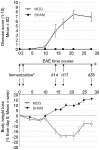Identification of VHY/Dusp15 as a regulator of oligodendrocyte differentiation through a systematic genomics approach
- PMID: 22792334
- PMCID: PMC3394735
- DOI: 10.1371/journal.pone.0040457
Identification of VHY/Dusp15 as a regulator of oligodendrocyte differentiation through a systematic genomics approach
Abstract
Multiple sclerosis (MS) is a neuroinflammatory disease characterized by a progressive loss of myelin and a failure of oligodendrocyte (OL)-mediated remyelination, particularly in the progressive phases of the disease. An improved understanding of the signaling mechanisms that control differentiation of OL precursors may lead to the identification of new therapeutic targets for remyelination in MS. About 100 mammalian Protein Tyrosine Phosphatases (PTPs) are known, many of which are involved in signaling both in health and disease. We have undertaken a systematic genomic approach to evaluate PTP gene activity in multiple sclerosis autopsies and in related in vivo and in vitro models of the disease. This effort led to the identification of Dusp15/VHY, a PTP previously believed to be expressed only in testis, as being transcriptionally regulated during OL differentiation and in MS lesions. Subsequent RNA interference studies revealed that Dusp15/VHY is a key regulator of OL differentiation. Finally, we identified PDGFR-beta and SNX6 as novel and specific Dusp15 substrates, providing an indication as to how this PTP might exert control over OL differentiation.
Conflict of interest statement
Figures











Similar articles
-
The Dual-specificity phosphatase Dusp15 is regulated by Sox10 and Myrf in Myelinating Oligodendrocytes.Glia. 2016 Dec;64(12):2120-2132. doi: 10.1002/glia.23044. Epub 2016 Aug 17. Glia. 2016. PMID: 27532821
-
Activity of a newly identified serine protease in CNS demyelination.Brain. 2002 Jun;125(Pt 6):1283-96. doi: 10.1093/brain/awf142. Brain. 2002. PMID: 12023317
-
VHY, a novel myristoylated testis-restricted dual specificity protein phosphatase related to VHX.J Biol Chem. 2004 Jul 30;279(31):32586-91. doi: 10.1074/jbc.M403442200. Epub 2004 May 11. J Biol Chem. 2004. PMID: 15138252
-
Sox2 Is Essential for Oligodendroglial Proliferation and Differentiation during Postnatal Brain Myelination and CNS Remyelination.J Neurosci. 2018 Feb 14;38(7):1802-1820. doi: 10.1523/JNEUROSCI.1291-17.2018. Epub 2018 Jan 15. J Neurosci. 2018. PMID: 29335358 Free PMC article.
-
Nudging oligodendrocyte intrinsic signaling to remyelinate and repair: Estrogen receptor ligand effects.J Steroid Biochem Mol Biol. 2016 Jun;160:43-52. doi: 10.1016/j.jsbmb.2016.01.006. Epub 2016 Jan 14. J Steroid Biochem Mol Biol. 2016. PMID: 26776441 Free PMC article. Review.
Cited by
-
Disease-specific molecular events in cortical multiple sclerosis lesions.Brain. 2013 Jun;136(Pt 6):1799-815. doi: 10.1093/brain/awt110. Epub 2013 May 17. Brain. 2013. PMID: 23687122 Free PMC article.
-
Gene expression changes underlying cortical pathology: clues to understanding neurological disability in multiple sclerosis.Mult Scler. 2013 Sep;19(10):1249-54. doi: 10.1177/1352458513500554. Mult Scler. 2013. PMID: 23996595 Free PMC article. Review.
-
Critical Roles of Dual-Specificity Phosphatases in Neuronal Proteostasis and Neurological Diseases.Int J Mol Sci. 2017 Sep 13;18(9):1963. doi: 10.3390/ijms18091963. Int J Mol Sci. 2017. PMID: 28902166 Free PMC article. Review.
-
Comprehensive protein tyrosine phosphatase mRNA profiling identifies new regulators in the progression of glioma.Acta Neuropathol Commun. 2016 Sep 1;4(1):96. doi: 10.1186/s40478-016-0372-x. Acta Neuropathol Commun. 2016. PMID: 27586084 Free PMC article.
-
Dual specificity phosphatase 15 regulates Erk activation in Schwann cells.J Neurochem. 2017 Feb;140(3):368-382. doi: 10.1111/jnc.13911. Epub 2017 Jan 9. J Neurochem. 2017. PMID: 27891578 Free PMC article.
References
-
- Chang A, Tourtellotte WW, Rudick R, Trapp BD. Premyelinating oligodendrocytes in chronic lesions of multiple sclerosis. N Engl J Med. 2002;346:165–173. - PubMed
-
- Emery B. Regulation of oligodendrocyte differentiation and myelination. Science. 2010;330:779–782. - PubMed
-
- Jessen KR, Mirsky R. Negative regulation of myelination: relevance for development, injury, and demyelinating disease. Glia. 2008;56:1552–1565. - PubMed
Publication types
MeSH terms
Substances
Grants and funding
LinkOut - more resources
Full Text Sources
Medical
Molecular Biology Databases
Miscellaneous

